Cultivation methods and precautions of potted Stagelaria
St. regina is a flower with ornamental value. St. regina blossoms from September to June of the following year. The shape of the flower is like a crane looking up from afar. It has a beautiful shape and is loved by many friends. St. regina can not only be planted as a potted plant, but also a good helper for home decoration. It can also be placed in the courtyard for free cultivation to achieve the function of viewing and purifying the air.

St. Regina, we also call it paradise bird flower, bird of paradise flower, St. Regina is a kind of precious cut flower, beautiful and strange shape, like crane independence, looking far away, like birds flying, more like lovers tender eyes. Strelitzia posture beautiful, color not Yan not Jiao, elegant and generous. Today's Xiaobian and everyone share is the introduction of the breeding method and precautions of St. Regis.
Light: St. regina likes to grow in a sunny environment, but in summer it will be afraid of strong light exposure, so proper shading treatment should be done when breeding in summer. The appropriate light intensity for St. regina in the growth period is 30000Lx. In summer, if the exposure is excessive, the leaves will roll in and grow slowly. Insufficient sunlight in winter will also lead to excessive leaf growth or thin and bent petioles, which is not easy to bloom. Therefore, the cultivation of Stagonia should not be shady in winter and not exposed to sunlight in summer, otherwise it will affect the yield of cut flowers.
Temperature: The suitable growth temperature of St. regina is 18-24 degrees Celsius, higher than 40 degrees Celsius in summer will lead to growth retardation, winter below 0 degrees Celsius and below will also suffer from freezing damage, the general culture temperature is not less than 10 degrees at night in winter, during the day at about 20 degrees can also flower, St. regina grows in the appropriate temperature range when each leaf axil can form flower buds and sprout flowers, so good temperature control is the key to improve the amount of St. regina flowers.
Soil: St. regina is a fleshy root system afraid of water, so the soil for breeding St. regina is too humid and poor ventilation will cause the occurrence of rotten roots. Generally, sufficient water should be supplied during flowering and summer. After early spring and flowering, it is necessary to reduce the amount of watering appropriately. In order to improve the humidity in the air and ensure that St. regina can fully absorb water, the above-ground part of the plant also needs timely spraying, so that the air humidity during the growth period is maintained at 60% to 70%.
Watering: The amount of watering depends on seasonal changes, plant growth conditions and actual soil dryness and wetness. Generally speaking, watering should be dry and wet, summer watering should be sufficient, spring and summer season should also often spray water on the leaves and on the ground around the flowerpot to improve the air humidity, create a cool environment, conducive to its growth and development. After late autumn to reduce watering, winter to control watering, in order to keep the pot soil dry as well.
Fertilizer: During the growth period of St. Regis, it is necessary to apply fertilizer every 20 days or so. It is best to use fertilizer water with decomposed cake. It is necessary to apply phosphorus and potassium-based compound fertilizer for 2 to 3 times from flower stem formation to full flowering stage. In autumn, the amount of nitrogen fertilizer should be appropriately reduced to prevent excessive growth of stems and leaves and affect flower bud development and cold resistance. In summer, because the plant is in a semi-dormant state, the amount of fertilizer and water should be reduced. Remember to stop fertilizing in winter, loosen the soil by weeding and weeding, and increase aeration.
Change pot: Generally, it is advisable to change pot once a year during seedling stage. After flowering, the adult plants can be replaced every one year. When changing pots, dig up the whole clump of St. Regis plants from the soil (with roots as much as possible). After the roots and the gaps between buds and buds can be clearly distinguished, reasonably select the cutting opening according to the size of the plants on the premise of ensuring that there are 2~3 buds in each clump, and divide the mother plants into 2~3 clusters from the gaps of the rhizomes with a sharp knife. The cut should be stained with plant ash and dried in a ventilated place for 3 to 5 hours. Excessive roots can be cut short appropriately and planted.
Notes:
1, summer shading: in the south subtropical region, summer shading net for St. Regis plant shading, can reduce the plant and leaves by strong sunlight and high temperature exposure and burns, keep the plant growing well. Sunshading treatment in summer could obviously reduce the first-class flower rate of cut flowers. Because of the low price in summer market, the price is only about 20% of the peak demand season, so we should control the output of cut flowers in summer, reduce the number of listed plants, protect the plants to pass through summer smoothly, so as to improve the output and quality of cut flowers in winter and spring market demand season.
2. Winter canopy: The temperature in December to March of the next year in winter and spring in the southern part of the province is relatively low, and the cold wave in the north often invades, and the cut flower yield of St. Regis is less, while the market demand for cut flowers increases at this stage, and the price rises. The results showed that the yield of cut flowers increased by 300% compared with that of open field, especially in small arched shed. The simple thin film small arch shed is easy to obtain materials and cover, low in cost, good in heat preservation and flower promotion effect, and suitable for rural growers.
Time: 2019-06-01 Click:
- Prev

Maintenance and management methods of potted flower tobacco
Tobacco is an annual herb of Solanaceae, there are about 60 species of tobacco, but what is really used to make cigarettes and cut tobacco is safflower tobacco, in addition, there are a small number of yellow-flowered tobacco, other varieties are rarely used. Tobacco flowers are widely planted because of their beauty and fragrance and often bloom in the evening or cloudy days.
- Next

How to raise Cymbidium in potted plants
The leaves of Cymbidium are slender, plump and gorgeous, with large flowers and standing tall. Each plant often blossoms two or three branches, in full bloom, such as brocade heap embroidery, reflect each other, magnificent, extraordinary momentum. Large plants are mostly used for cut flower cultivation, small and medium-sized plants are mostly used as potted plants, suitable for decorating living rooms, windowsills and so on. that
Related
- Fuxing push coffee new agricultural production and marketing class: lack of small-scale processing plants
- Jujube rice field leisure farm deep ploughing Yilan for five years to create a space for organic food and play
- Nongyu Farm-A trial of organic papaya for brave women with advanced technology
- Four points for attention in the prevention and control of diseases and insect pests of edible fungi
- How to add nutrient solution to Edible Fungi
- Is there any good way to control edible fungus mites?
- Open Inoculation Technology of Edible Fungi
- Is there any clever way to use fertilizer for edible fungus in winter?
- What agents are used to kill the pathogens of edible fungi in the mushroom shed?
- Rapid drying of Edible Fungi

